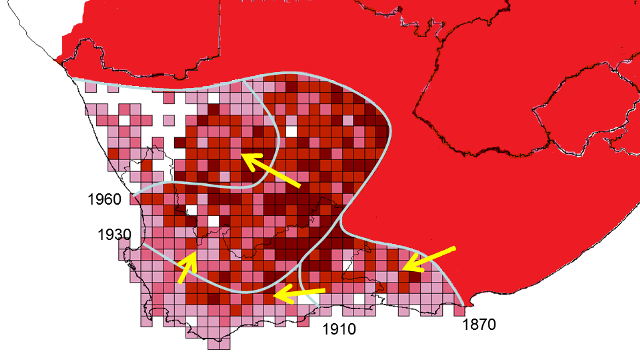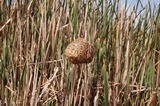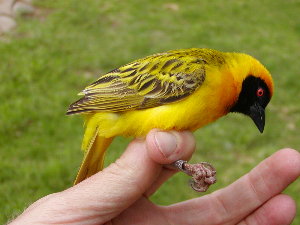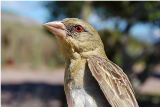Weaver news
|
The Southern Masked Weaver male in breeding plumage (photo above left) is bright yellow with a black mask and red eye. In non-breeding plumage it resembles the dull-coloured female, but retains a reddish eye. The female usually has a brown eye but about 29% of breeding females have a reddish eye (photo above right, see pdf paper on weaver eye colours). This species is gregarious when not breeding, often roosting and feeding in large numbers. It is mainly a seed-eater, although also feeds on arthropods, nectar, and other items. It is found in a wide variety of habitats, including gardens, but is usually less common in coastal regions. The Southern Masked Weaver has no subspecies listed in the Handbook of the Birds of the World, Vol. 15. Several subspecies have been proposed in the past, but this species is likely to show penotypic variation, ie. the size and plumage variation is due to environmental factors rather than geographic variation in genotypes. It is found in the southern third of Africa as far north as Angola, Zambia, Malawi and Mozambique. It did not occur in the Western Cape historically (plain red in map below). Originally its distribution ranged from the lower Orange River across to Port Elizabeth. It then expanded its range into the Western Cape and then Northern Cape as shown in the map. In its new range the SABAP1 (1987-1991) range is shown - it is still sparse in the arid region south of the lower Orange River.  The Southern Masked Weaver is polygnous. The male builds a neat nest which contains a ceiling inside the main structure as rain-protection. If a female accepts a nest, she lines the chamber with grass seed heads or feathers. Nests are built in trees, bushes, reeds, bamboos or man-made structures, like barbed wire fences. The latter is well illustrated by the very first PHOWN record (Photo below, phown 1).
The Southern Masked Weaver has more PHOWN records than any other species. There are, however, no PHOWN records from Botswana, Malawi and Mozambique, and only one record from Zambia. Please look out for nests of this species in any country in its range and submit to PHOWN (PHOtos of Weaver Nests) via the Virtual Museum upload site. PHOWN records for the Southern Masked Weaver appear here. PHOWN records for this species Previous Wedn: Compact Weaver Full weaver species list |












 The Southern Masked Weaver Ploceus velatus is part of the largest genus in the weaver family, namely Ploceus, this name meaning "a weaver or braider", referring to the group's ability to weave their nests. This genus with 61 species is one of the larger ones in the avian world, but is likely to be split when a genetic analysis is complete. The genus contains weavers throughout sub-Saharan Africa, southern Asia and Madagascar. There are many polygnous species, where the male tries to attract several females to breed in his territory, as well as many monogamous species where one pair remains together for a breeding season or even many years.
The Southern Masked Weaver Ploceus velatus is part of the largest genus in the weaver family, namely Ploceus, this name meaning "a weaver or braider", referring to the group's ability to weave their nests. This genus with 61 species is one of the larger ones in the avian world, but is likely to be split when a genetic analysis is complete. The genus contains weavers throughout sub-Saharan Africa, southern Asia and Madagascar. There are many polygnous species, where the male tries to attract several females to breed in his territory, as well as many monogamous species where one pair remains together for a breeding season or even many years.
 Colonies in drier areas tend to be larger with several males present, while this weaver tends to disperse into single-male colonies in urban areas. Eggs vary in colour, bluish or whitish, being plain or marked with fine or larger spots and blotches. This is one of the most common host species to the Diederik Cuckoo. One of the most abnormal weaver nests was built by this species - see
Colonies in drier areas tend to be larger with several males present, while this weaver tends to disperse into single-male colonies in urban areas. Eggs vary in colour, bluish or whitish, being plain or marked with fine or larger spots and blotches. This is one of the most common host species to the Diederik Cuckoo. One of the most abnormal weaver nests was built by this species - see